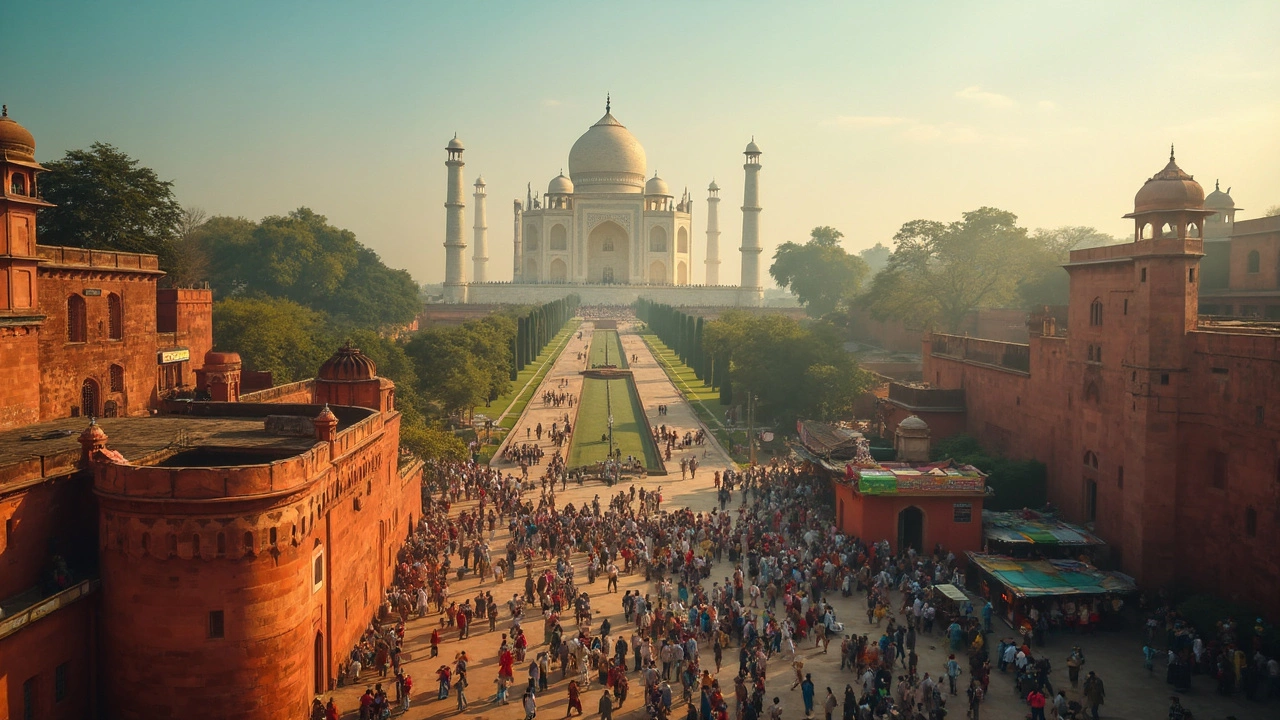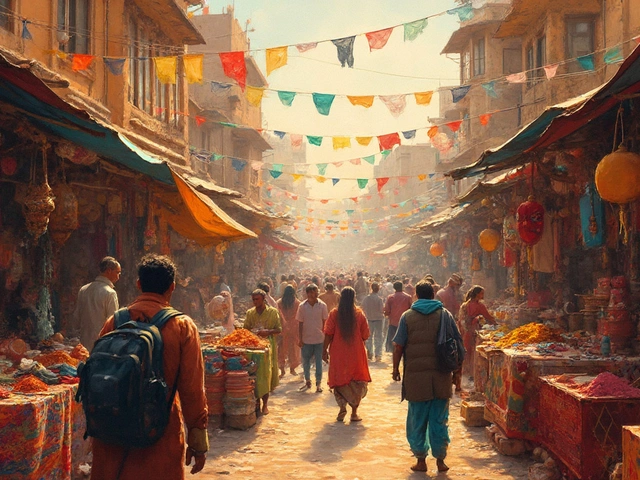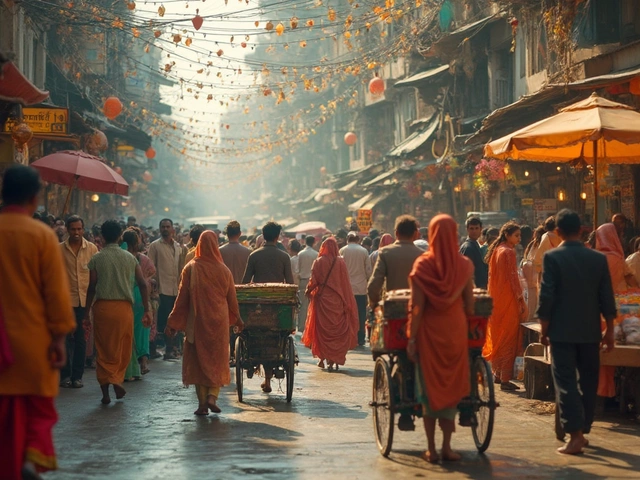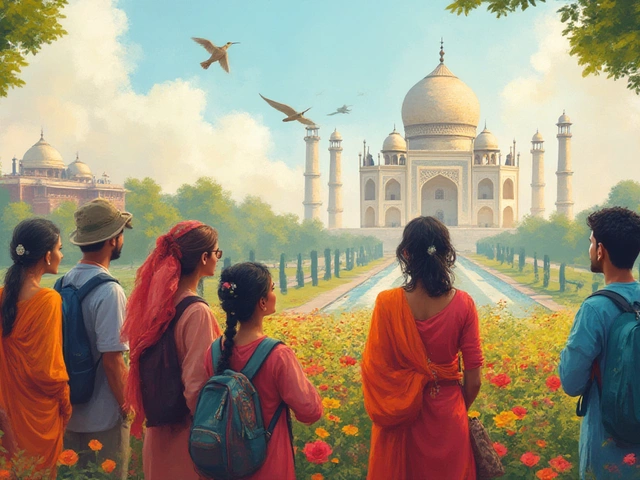Picture this: you’re standing under the massive arch of the India Gate, or catching that first glimpse of the Taj Mahal glowing at sunrise. Doesn’t sound as great if you’re dripping sweat or elbowing through a megacrowd, right? Picking when to hit India’s Golden Triangle can totally shape your experience—more than you’d think.
Here’s the deal: North India swings between chilly winters, a fiery hot summer, and a wild monsoon. In some months, you risk oven-hot afternoons or streets flooded by rainstorms. Other times, the weather feels just right for exploring markets, strolling forts, or sipping chai in a quiet courtyard.
Beyond just the climate, certain months bring big festivals, school holidays, and crowd surges you probably want to know about. If you want those Instagram-worthy photos minus the pushing and sweating, timing is everything. Looking for deals? Traveling off-season can sometimes mean steep hotel discounts, but there’s a trade-off.
I’ve been through Delhi’s bustling winter bazaars, sweated my way up to Amber Fort in May, and even got caught in a summer downpour in Agra with Amara laughing at my attempt to use a street vendor’s umbrella. The ideal season for you depends on what you value: easy sightseeing, festival energy, or a bargain adventure. Let’s break down what each part of the year really brings in this travel triangle.
- Why Weather Matters for the Golden Triangle
- What Each Season Really Feels Like
- Crowds, Festivals, and Local Events
- Tips for Scoring Deals and Avoiding Hassles
- Personal Experiences and Off-Season Surprises
Why Weather Matters for the Golden Triangle
If you ask anyone who’s done the Golden Triangle circuit (Delhi, Agra, Jaipur), they’ll usually tell you the weather can make or ruin the whole trip. The climate in North India is wild—there’s no gentle middle ground. In a single year, you’ll find bone-chilling mornings, afternoons so hot they send locals running for shade, and summer rains that turn streets into little rivers.
Most visitors want clear blue skies for their Taj Mahal photos, comfortable walks through Jaipur’s old city, and enough cool air to handle all the spicy street food. That rarely happens at random. For example, from April to June, Delhi and Agra can reach 42°C (that’s 108°F)—the kind of heat that leaves even locals sweating and ruins your sightseeing stamina.
Then there’s the monsoon, landing from late June to September. You might be tempted by cheaper hotels and fewer tourists, but sudden downpours aren’t fun when you’re trying to cross town or visit outdoor markets. Streets flood quick, and umbrellas are more decoration than help. Still, rain can make Jaipur’s forts look dramatic and brilliant against dark clouds, if you don’t mind dodging puddles.
If you visit from October to March, you’ll see why it’s peak season—mild temperatures hover from 8°C in the chilly mornings up to 25°C later in the day (46°F to 77°F). This is when the historic sites are packed, but exploring them feels way easier. Evenings can get brisk, so pack a jacket.
Basically, the whole triangle’s rhythm changes month to month. Picking the wrong time could mean missing big sights because you’re hiding inside a cafe, or getting the dreaded “Taj Mahal sweat stains” in your trip photos. Weather isn’t everything, but for this region, it’s a huge deal. Whatever you plan, check the forecast in advance and pack for big swings between day and night, sun and showers.
What Each Season Really Feels Like
The Golden Triangle—Delhi, Agra, and Jaipur—runs on its own rhythm every season, and trust me, each has a distinct vibe. Whether you’re deciding between cozy winter sweaters or buckets of sunscreen, here’s what you’ll actually face during your trip.
Golden Triangle weather pretty much falls into three main chunks: winter (October to February), summer (March to June), and monsoon (July to September). The way they hit you is different in each city, but the pattern stays pretty true across the region.
| Season | Typical Temperatures (°C) | Vibe | Main Pros | Main Cons |
|---|---|---|---|---|
| Winter | 7–22 | Cool, crisp, comfortable | Best for sightseeing, festivals | Can get crowded (peak season) |
| Summer | 25–45 | Hot, dry, intense sun | Fewer tourists, good deals | Unbearably hot at mid-day |
| Monsoon | 24–34 | Humid, frequent rain | Lush scenery, low hotel rates | Travel delays, wet clothes |
Winter (October to February): This is the top pick for most travelers. The air is crisp, skies are blue, and you won’t sweat buckets while exploring. Delhi can get pretty chilly mornings (I’ve seen 7°C at sunrise!), but a light jacket does the job. Agra and Jaipur feel just right for roaming the forts, especially if you like taking photos without squinting. Bonus: it’s when the region’s big festivals light up the cities, from Diwali lights in the markets to Jaipur’s January kite festival.
Summer (March to June): Here’s where things get wild. Temperatures can touch 45°C by late May. Locals try to wrap up work by noon, because afternoons can cook you. Sights like the Taj Mahal and Amber Fort are almost empty in the hottest part of the day, which can be great if you don’t mind the heat and want zero crowds. If you try this, think breathable clothes, lots of water, and shading your face like a pro.
Monsoon (July to September): When the rains hit, the Triple City gets a reset—think cleaner air and green gardens. Jaipur’s pink gets a fresh pop against the clouds, and Delhi’s parks finally cool off. But you have to deal with sudden downpours, flooded streets, and schedule changes; Agra’s Yamuna river sometimes overflows too. On the bright side, hotels go cheap, and tourist numbers drop. I once found a fancy Delhi room for half price in August! Just pack a light raincoat and waterproof shoes.
- If you’ve got allergies, be aware Delhi’s winter can get foggy and smoky due to pollution.
- In summer, most monuments open super early—aim for sunrise if you want to explore before the streets heat up.
- Public transport in monsoon might get messy. Keep buffer time for delays.
The months from November to mid-February are without a doubt the crowd favorite, but making your plans work with weather and crowds means thinking like a local, not just going by the calendar.
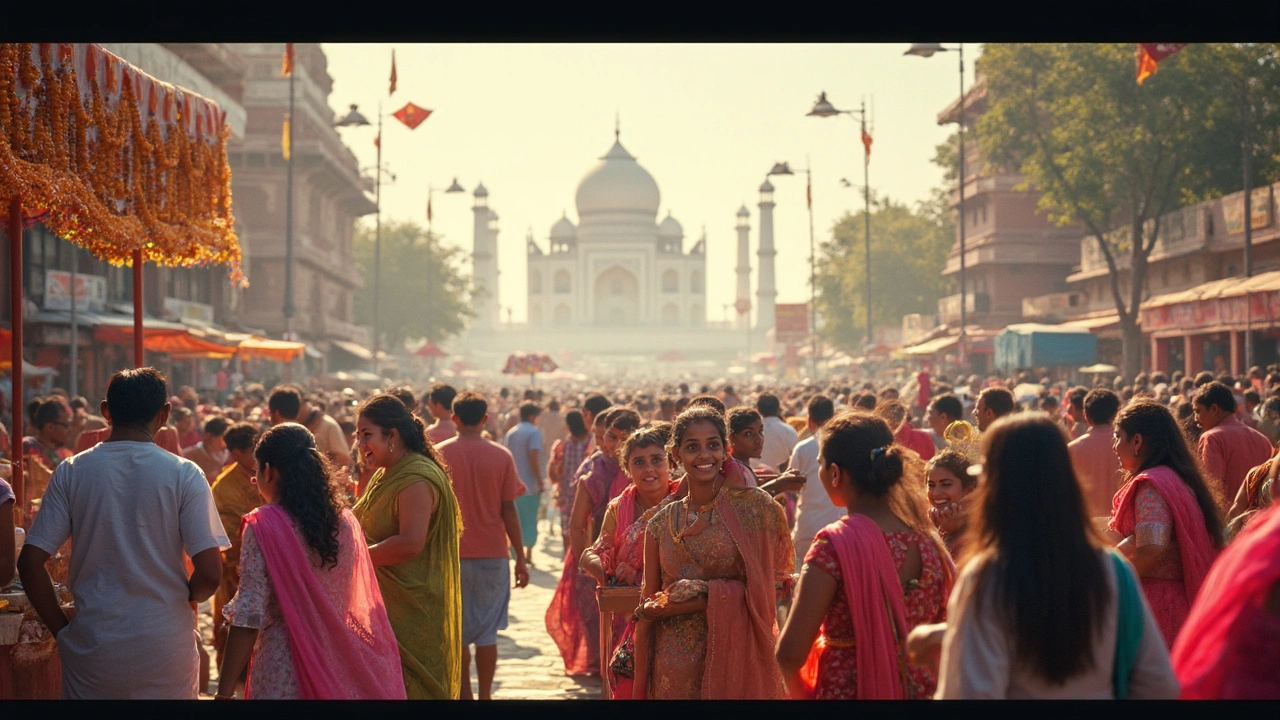
Crowds, Festivals, and Local Events
Think the Golden Triangle is just a line on the map? Wait until you deal with the crowds during peak festivals! Between Delhi, Agra, and Jaipur, each city cranks up the energy for special events, and tourist numbers shoot up big time. Plan right, and you might score a front-row seat to some of India’s most colorful traditions. Plan wrong, and you might only see the back of a hundred heads in your Taj selfie.
Winter, from November to February, is prime time for tourists. Monuments get packed, hotel prices climb, and lines can be long. In 2024 alone, over 8 million people visited these three cities during peak season (according to the Ministry of Tourism report).
| Season | Crowd Level | Major Events |
|---|---|---|
| November–February | Very High | Diwali (Oct-Nov), Jaipur Literature Festival (Jan), Republic Day (Jan 26) |
| March–April | Moderate | Holi (March), Elephant Festival (Jaipur, March) |
| May–June | Low | Fewer events, schools out, hot weather |
| July–September | Low–Moderate | Teej Festival (July/Aug), Independence Day (Aug 15) |
Here’s a tip: Some of the best experiences come from catching a festival even if it’s crowded. Holi, the Hindu festival of colors, explodes onto the streets in March. Jaipur, especially, throws wild celebrations, but book your stay well ahead if you hope to join in.
- Jaipur Literature Festival: Every January, writers, poets, and thinkers from around the world fill the city’s Diggi Palace. If you love books, it’s worth weaving into your trip, but know the city gets absolutely packed.
- Republic Day in Delhi: Massive parade, tanks rolling, school kids dancing—it’s a real show. Spots fill up fast near India Gate.
- Diwali: Agra and Jaipur light up for this one. Streets get jammed, but the vibe is unbeatable.
Need a breather from the crowds? Consider traveling just before or after peak times—think late October or early March. The weather’s still decent, but you’ll dodge the worst of the rush.
"If you want to see India’s Golden Triangle at its liveliest, come during the festival season—but only if you can handle crowds. There’s nothing like it," says travel journalist Ritu Singh for Lonely Planet India.
In short: keep an eye on the festival calendar, brace yourself for crowds at the big sites during winter, and don’t underestimate how a major event can reshape your whole trip—sometimes for the better.
Tips for Scoring Deals and Avoiding Hassles
If you’re eyeing the Golden Triangle for your next trip, you can actually save cash and dodge annoyances with just a few smart moves. Here’s what helps most regular travelers (like me and Amara) not only stretch their rupees, but stay sane in the middle of the action.
- Book Flights and Hotels Early for Peak Season: If you’re set on a winter trip (November to February), book flights and especially hotels at least three months in advance. Rates in Delhi, Agra, and Jaipur jump by up to 30% when the weather is good. Look around Diwali and Christmas—those fill up fast.
- Go Off-Season for Serious Savings: Brave the shoulder seasons—like March, April, and September—for discounts up to 40%. Some top-tier hotels in Jaipur drop from $200 a night to under $120. Yes, it might be warmer or a little muggy, but monuments are quieter, and deals are real.
- Bargain in Markets: From Delhi's Sarojini Nagar to Jaipur's Bapu Bazaar, prices are always negotiable. Start by offering 30% below the quoted price and meet somewhere in the middle. Vendors expect you to haggle.
- Travel by Train or Ride-Sharing: India's trains are cheaper than private taxis on most Golden Triangle routes, and booking AC Chair cars in advance is simple on IRCTC. For local rides, Uber and Ola tend to be fair and avoid the old tourist overpricing game.
- Use Official Ticket Counters for Attractions: Skip "guides" at entrances who claim shortcuts—buy your entry tickets for sites like the Taj Mahal, Red Fort, or City Palace at the official kiosks or online. E-tickets also jump you past bigger lines now.
- Watch for Festival Surcharges: During Holi (March) and Diwali (October/November), expect hotels in Jaipur to tack on "festival rates"—sometimes 50% more. If you’re not coming for the party, steer clear, but if you love the vibe, book way ahead.
For a big-picture look, here’s a mini table showing what you can expect to pay if you visit in different months:
| Month | Avg. 3-Star Hotel (per night) | Popular Attraction Entry Fee (Taj Mahal) |
|---|---|---|
| December | $70 | $13.50 |
| March | $56 | $13.50 |
| May | $44 | $13.50 |
| August | $50 | $13.50 |
One final tip—keep copies of your booking confirmations, especially for trains and hotels. Sometimes names get misspelled or dates show up wrong in the system. It’s way less hassle if you have a screenshot to show.
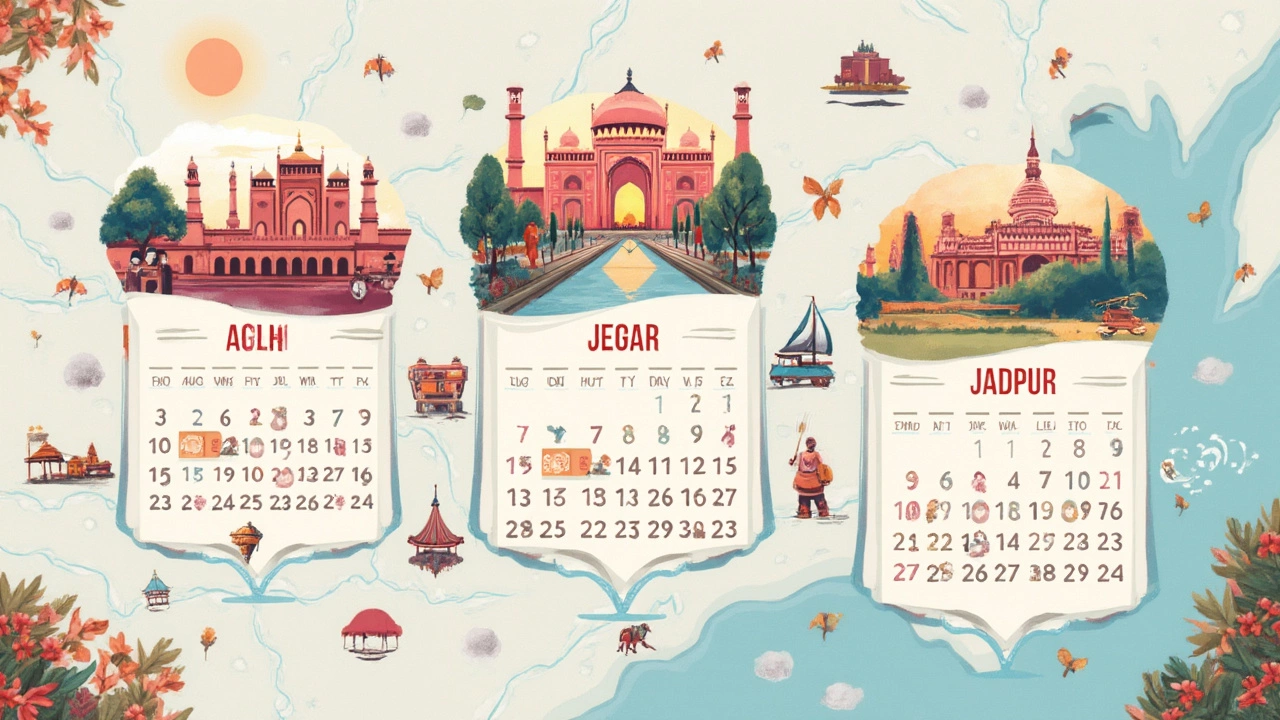
Personal Experiences and Off-Season Surprises
You might hear folks say, “Never visit North India in summer,” but that’s only half the story. It’s hot, no sugar-coating it, and I’ve roasted under the Agra sun. But here’s what surprised me: the biggest Golden Triangle hotspots, like the Red Fort and the Hawa Mahal, are usually way less crowded in the off-season. Sure, you’ll sweat a bit more, but there’s something nice about having these jaw-dropping sights almost to yourself.
I remember one trip in late June—temps hovering around 39°C (that’s 102°F, if you’re counting). Sounds bad, but I snagged a great hotel in Jaipur at less than half what they charged in January. Staff actually let me linger by the pool all morning because barely anyone else was checked in. That was a game-changer for the budget and the peace of mind.
Rainy (monsoon) months bring their own quirks, mostly between July and September. Expect afternoon downpours, especially in Delhi and Agra. The plus? The gardens around the Taj Mahal turn bright green. If you’re after that perfect green-lawn photo, this is your chance. But be ready—sometimes the rain can flood certain roads, making travel slow and stopping some outdoor attractions for a while.
Here’s a quick breakdown of what I’ve seen around the Golden Triangle, based on the season:
| Month | Weather | Crowds | Deals |
|---|---|---|---|
| December–February | Cool (8-20°C), dry | Very busy | Hotels at peak prices |
| March–April | Warming up (20-32°C) | Medium | Some discounts |
| May–June | Hot (35-45°C) | Low | Big hotel savings |
| July–September | Humid, rainy (25-33°C) | Low–Medium | Discounts, but watch for rain |
| October–November | Pleasant (18-32°C) | Increasing | Mid-level prices |
Don’t write off the off-season if you have a tight schedule or want to save money. Just pack light clothes, carry a refillable water bottle, and get a sun hat that doesn’t make you look like you’re on safari. Also, always check that your hotel has backup power (monsoon storms can cut the juice!). The big draw? Space to explore—and some awesome travel stories to tell later. Who can say they had the Taj Mahal practically to themselves?
